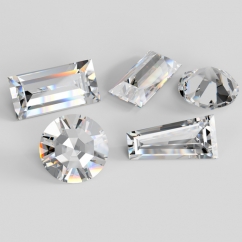Articles and News
Diamond Industry Giants Combat the Rise of Lab-Grown Diamonds with New Strategies June 18, 2024 (0 comments)

New York, NY--The world's two largest diamond companies, Signet Jewelers and De Beers, are addressing the increasing popularity of lab-grown diamonds, which industry insiders see as a threat.
[Image via istockphoto.com]
In May, Signet Jewelers, the biggest diamond retailer globally with brands like Jared, Zales, Kay, and Blue Nile, started printing disclaimers on receipts for lab-grown diamonds. Per a report in the New York Post, the disclaimer warns that the value of these diamonds may decline due to their relative abundance. Signet is also training its 20,000 sales associates to inform customers about natural diamonds' unique qualities and enduring value.
De Beers, the largest diamond producer, introduced a new diamond verification machine last month. This device is intended to assure buyers that they are purchasing natural diamonds, which are nearly indistinguishable from lab-grown diamonds to the naked eye, even for trained jewelers.
These efforts come as Signet and De Beers prepare for extensive marketing campaigns to promote natural diamonds, anticipating a post-pandemic surge in wedding engagements. Diamond analyst Paul Zimnisky noted in the report that this was the first significant collaboration between the largest seller and producer to support natural diamonds in two decades.
The diamond industry has faced challenges over the past year with the rise of lab-grown diamonds (LGDs), which have gained popularity for being conflict-free and environmentally friendly. Per the report, this trend has hurt De Beers, which saw a 21% sales decline in the mid-May quarter, following a 36% drop in 2023 and a $1.6 billion writedown.
The report highlighted that lab-grown diamonds now account for 19% of the market and could grow to 22% this year. The falling prices of LGDs, which have decreased by nearly 30% in the past year, have led to lower profit margins and oversupply in the market. Last month, De Beers reduced the price of its Lightbox LGD brand by 37% to $500 per carat, following a 10% price cut in January. De Beers' Element Six factories will also cease LGD production and return to industrial diamond manufacturing.
In recent years, India has joined China in ramping up the production of larger polished synthetic diamonds, further impacting prices. Per the report, Northcoast Research analyst Jim Sanderson attributes the oversupply to higher-than-expected production levels.
The report noted that Signet anticipates a 10% increase in engagements this year and a 25% rise over the next three years despite continued discounting. CEO Virginia Drosos suggested in the report that consumers are becoming more aware of the falling prices of lab-grown diamonds.
The coordinated efforts by Signet and De Beers aim to reshape consumer perceptions, emphasizing the lasting value of natural diamonds. "Marketing is such an important part of this industry," Zimnisky said, per the report. "It's really up to the diamond industry to explain why consumers should pay more for natural diamonds."
Learn more in this report by the New York Post.







